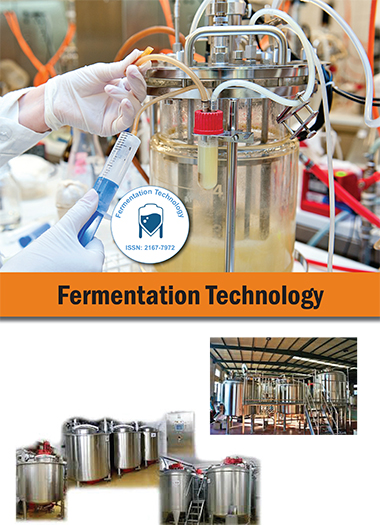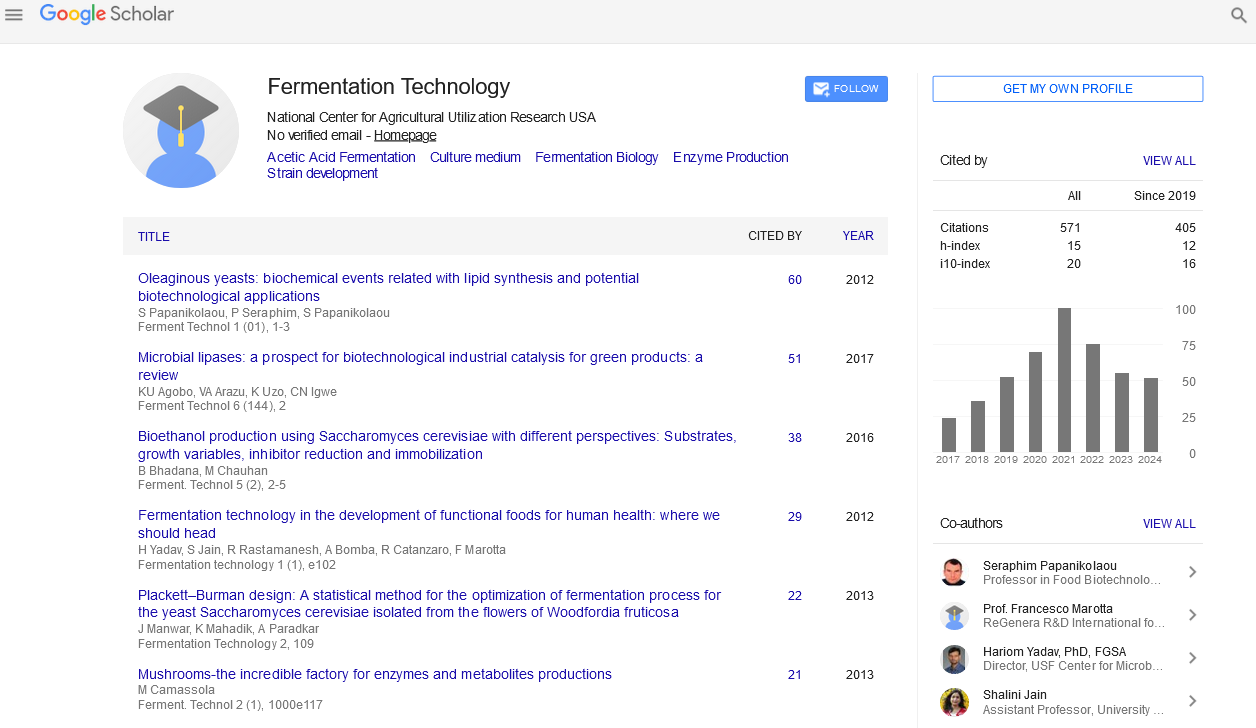Indexed In
- Open J Gate
- Genamics JournalSeek
- Access to Global Online Research in Agriculture (AGORA)
- RefSeek
- Hamdard University
- EBSCO A-Z
- OCLC- WorldCat
- Publons
Useful Links
Share This Page
Journal Flyer

Open Access Journals
- Agri and Aquaculture
- Biochemistry
- Bioinformatics & Systems Biology
- Business & Management
- Chemistry
- Clinical Sciences
- Engineering
- Food & Nutrition
- General Science
- Genetics & Molecular Biology
- Immunology & Microbiology
- Medical Sciences
- Neuroscience & Psychology
- Nursing & Health Care
- Pharmaceutical Sciences
Opinion Article - (2025) Volume 14, Issue 1
Bioreactor Design and Scale-Up Strategies in Modern Fermentation Technology: Challenges and Opportunities
Evangeline Rose*Received: 26-Feb-2025, Manuscript No. FMT-25-29073; Editor assigned: 28-Feb-2025, Pre QC No. FMT-25-29073 (PQ); Reviewed: 13-Mar-2025, QC No. FMT-25-29073; Revised: 20-Mar-2025, Manuscript No. FMT-25-29073 (R); Published: 27-Mar-2025, DOI: 10.35248/2167-7972.25.14.183
Description
Bioreactors are the core of industrial fermentation, providing a controlled environment for microbial or cell-based synthesis of desired products such as enzymes, organic acids, alcohols and biopharmaceuticals. As the demand for large-scale production of bio-based materials continues to grow, the focus on efficient bioreactor design and successful scale-up strategies has intensified. While laboratory-scale systems allow detailed control and rapid optimization, scaling up to commercial production presents technical and operational hurdles.
Key design parameters in bioreactors
A bioreactor must support optimal growth and product formation by regulating physical and chemical conditions. Several parameters must be considered during the design phase:
Agitation and mixing: Ensures homogeneous distribution of cells, nutrients and oxygen. The design of impellers and the position of baffles directly affect mixing efficiency.
Aeration and oxygen transfer: Aerobic processes rely on sufficient oxygen transfer. Oxygen Transfer Rate (OTR) and volumetric oxygen transfer coefficient (kLa) are critical for aerobic fermentations.
Temperature and pH control: Maintaining an optimal range is necessary for enzymatic and metabolic activities. Bioreactors typically include integrated heating/cooling systems and automated acid/base addition.
Foam control: Excessive foam formation can disrupt operation and is managed using mechanical foam breakers or chemical antifoaming agents.
Sterility: Especially important in pharmaceutical and food production. Sterile design, including proper seals, valves and cleaning systems (CIP/SIP), is essential.
Types of bioreactors
Different fermentation goals require different bioreactor configurations:
Stirred-Tank Reactors (STR): The most common type, offering versatility and scalability for various microbial systems.
Airlift and bubble column reactors: Useful for shear-sensitive organisms. They use gas sparging for mixing and aeration without mechanical agitation.
Packed-bed and fixed-bed reactors: Employed in solid-state fermentation or immobilized cell systems, offering high cell densities.
Membrane bioreactors: Combine biological treatment with membrane separation, suitable for continuous product removal.
Scale-up challenges
Moving from lab to pilot or industrial scale is rarely linear. Scale-up must consider several non-proportional factors:
Oxygen limitation: Large bioreactors often struggle with uniform oxygen distribution, especially in high-density cultures.
Heat transfer issues: Microbial metabolism generates heat that must be dissipated uniformly. Larger volumes pose challenges in maintaining consistent temperature.
Shear sensitivity: Increased agitation at scale can damage sensitive cells or enzymes. Selecting the right impeller type and speed is necessary to balance mixing with shear protection.
Contamination risk: Scale-up increases the risk of contamination due to longer process times and more complex equipment.
Sensor and control limitations: Real-time monitoring tools effective at small scale may not translate well to large volumes, requiring calibration and validation.
Strategies for effective scale-up
To address these challenges, several approaches are employed:
Geometric similarity: Scaling up based on constant ratio of height to diameter. While common, it does not guarantee consistent performance due to physical and biological changes.
Constant Power Input per Volume (P/V): Maintains consistent mixing intensity, which is useful for shear-sensitive processes.
kLa-based scaling: Focuses on maintaining oxygen transfer efficiency across scales, especially important in aerobic fermentations.
Use of Computational Fluid Dynamics (CFD): CFD simulations provide insights into fluid dynamics, mixing patterns and nutrient gradients in large vessels, enabling better design decisions.
Modular bioreactor systems: Using multiple smaller reactors operated in parallel allows flexible scaling without the complexity of a single large unit.
Smart bioreactor systems
Technological advances have introduced smart bioreactors equipped with automated sensors and real-time control systems. These systems utilize Process Analytical Technology (PAT) for continuous feedback and adjustment of critical parameters. Integration with software platforms and artificial intelligence enables predictive modeling and process optimization, especially useful in long-duration fermentations.
Economic and environmental considerations
Designing energy-efficient bioreactors helps reduce operational costs. Efficient impeller designs, reduced aeration demand and improved insulation contribute to lower energy usage. Cleaning- In-Place (CIP) and Sterilization-In-Place (SIP) systems help reduce water and chemical usage. Single-use bioreactors are being adopted in pharmaceutical and vaccine production to reduce contamination risk and cleaning requirements, though they may not be suitable for large-volume commodity fermentations.
Application-specific design considerations
For enzyme production: Requires high aeration and rapid nutrient turnover.
For bioethanol production: Tolerance to ethanol buildup and efficient sugar conversion are priorities.
For biopharmaceuticals: Sterility, containment and tight process control are paramount.
Conclusion
Modern fermentation requires bioreactor systems that are adaptable, efficient and scalable. From bench-scale development to full industrial deployment, careful consideration of design parameters and scale-up strategies is essential. With advancements in automation, modeling and modular technologies, the next generation of bioreactor systems will enable more consistent, economical and sustainable fermentation-based production across a wide range of industries.
Citation: Rose E (2025). Bioreactor Design and Scale-Up Strategies in Modern Fermentation Technology: Challenges and Opportunities. Ferment Technol. 14:183.
Copyright: © 2025 Rose E. This is an open-access article distributed under the terms of the Creative Commons Attribution License, which permits unrestricted use, distribution and reproduction in any medium, provided the original author and source are credited.

